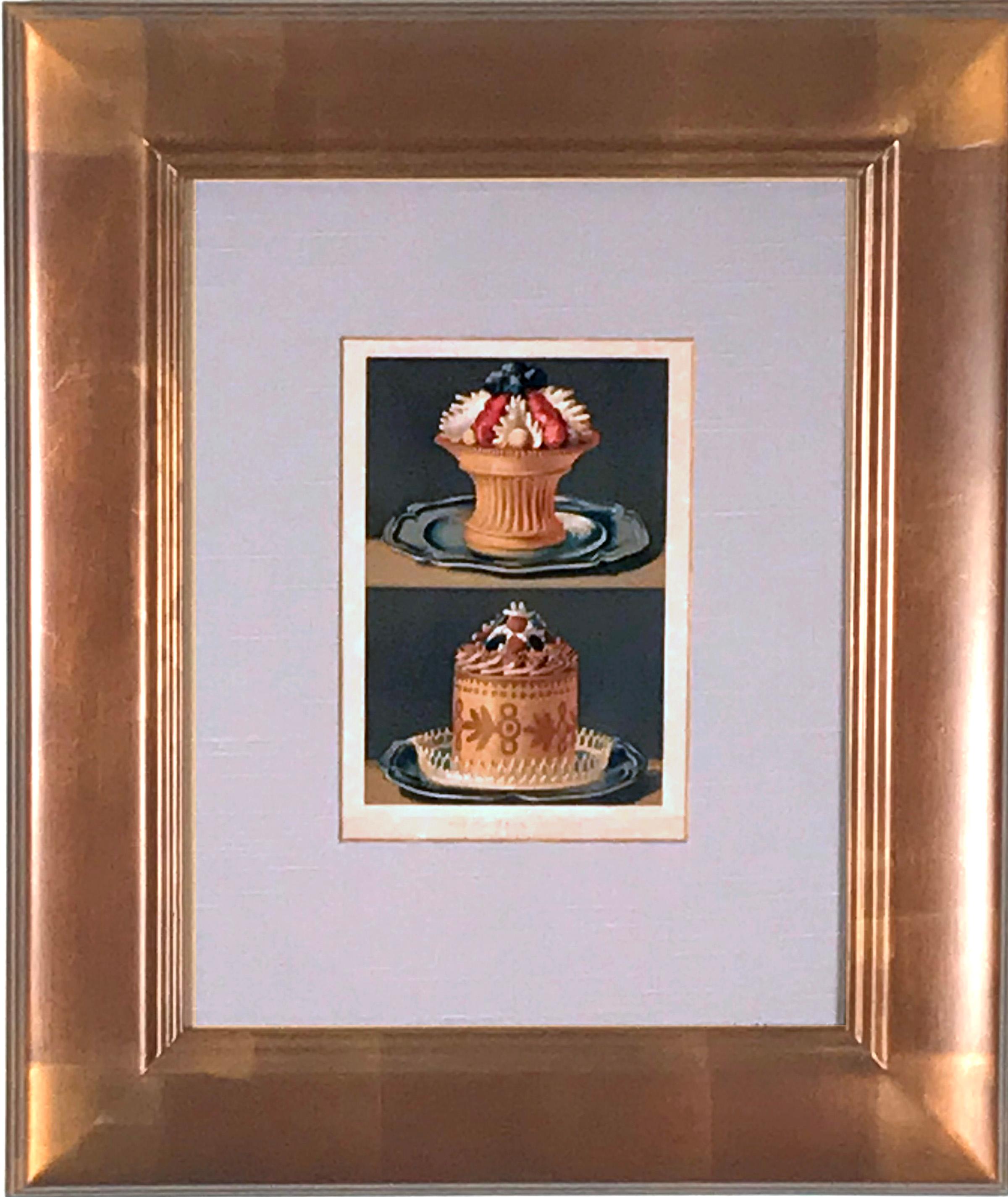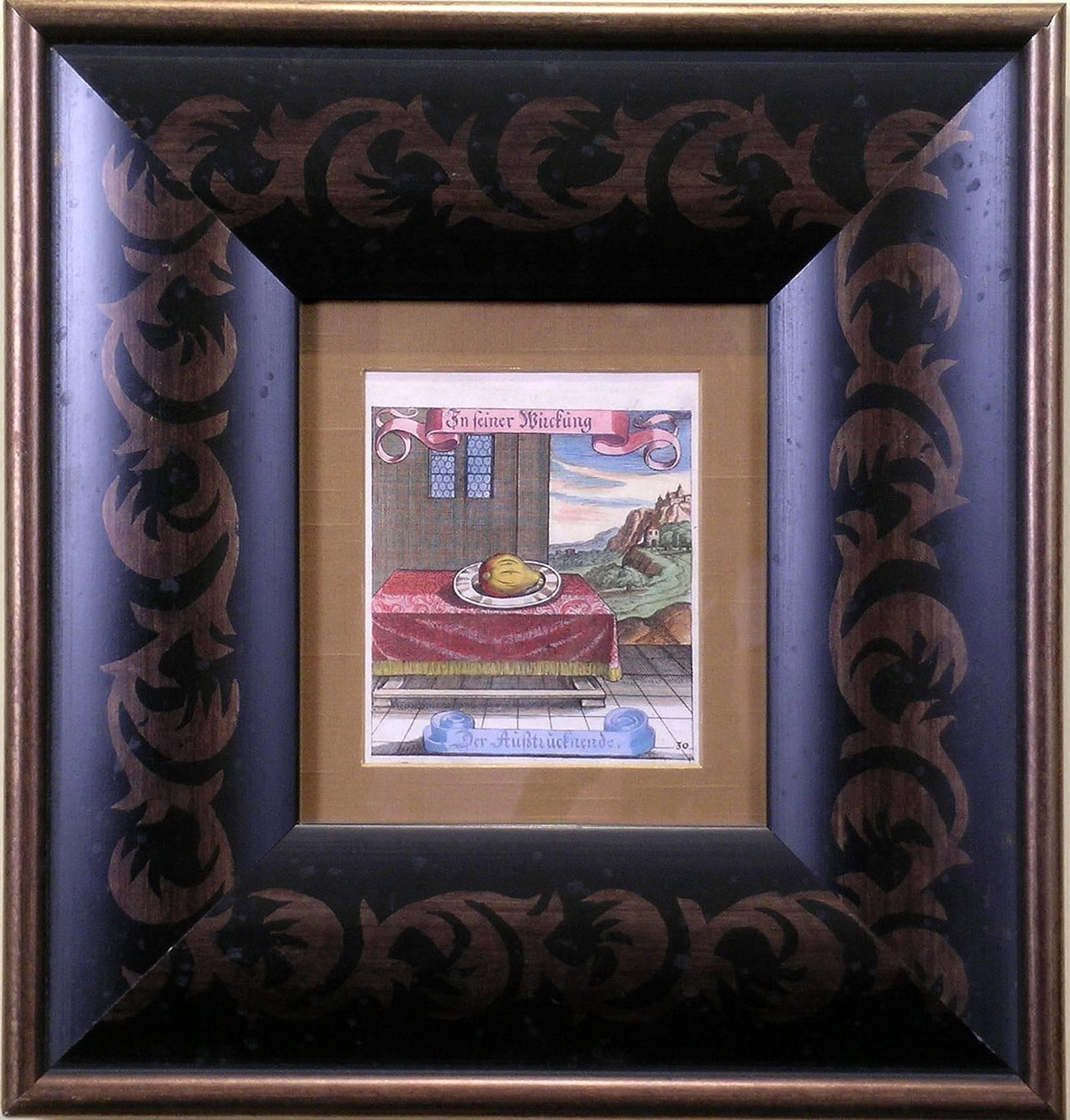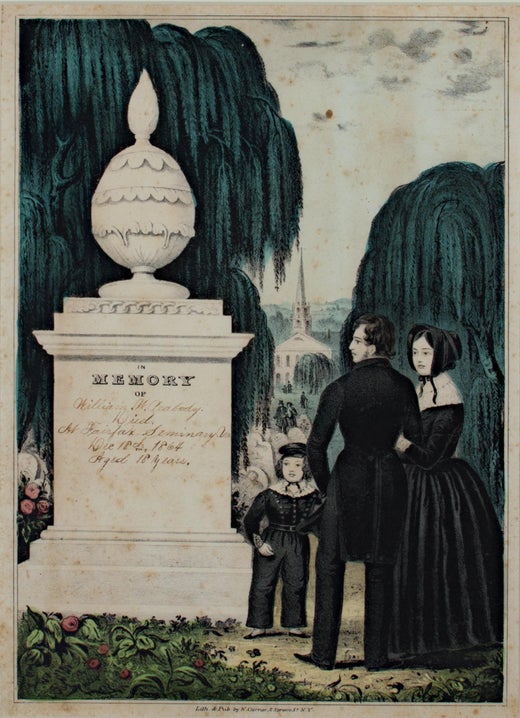Nathaniel Currier19th century color lithograph still life fruit flowers signed1848
1848
About the Item
- Creator:Nathaniel Currier (1813 - 1888, American)
- Creation Year:1848
- Dimensions:Height: 22.125 in (56.2 cm)Width: 18 in (45.72 cm)
- Medium:
- Movement & Style:
- Period:
- Condition:
- Gallery Location:Milwaukee, WI
- Reference Number:
Nathaniel Currier
Nathaniel Currier was a tall introspective man with a melancholy nature. He could captivate people with his piercing stare or charm them with his sparkling blue eyes. Nathaniel was born in Roxbury, Massachusetts on March 27, 1813, the second of four children. His parents, Nathaniel and Hannah Currier, were distant cousins who lived a humble yet spartan life. When Nathaniel was eight years old, tragedy struck. Nathaniel’s father unexpectedly passed away leaving Nathaniel and his eleven-year-old brother Lorenzo to provide for the family. In addition to their mother, Nathaniel and Lorenzo had to care for six-year-old sister Elizabeth and two-year-old brother Charles. Nathaniel worked a series of odd jobs to support the family, and at 15, he started what would become a life-long career when he apprenticed in the Boston lithography shop of William and John Pendleton. A Bavarian gentleman named Alois Senefelder invented lithography just 30 years before young Nat Currier’s apprenticeship. While under the employ of the brothers Pendleton, Nat was taught the art of lithography by the firm’s chief printer, a French national named Dubois, who brought the lithography trade to America.
In 1833, now 20-years old and an accomplished lithographer, Nat Currier left Boston and moved to Philadelphia to do contract work for M.E.D. Brown, a noted engraver and printer. With the promise of good money, Currier hired on to help Brown prepare lithographic stones of scientific images for the American Journal of Sciences and Arts. When Nat completed the contract work in 1834, he traveled to New York City to work once again for his mentor John Pendleton, who was now operating his shop located at 137 Broadway. Soon after the reunion, Pendleton expressed an interest in returning to Boston and offered to sell his print shop to Currier. Young Nat did not have the financial resources to buy the shop, but being the resourceful type he found another local printer by the name of Stodart. Together they bought Pendleton’s business. The firm Currier & Stodart specialized in job printing. They produced many different types of printed items, most notably music manuscripts for local publishers. By 1835, Stodart was frustrated that the business was not making enough money and he ended the partnership, taking his investment with him. With little more than some lithographic stones and a talent for his trade, 22-year old Nat Currier set up shop in a temporary office at 1 Wall Street in New York City. He named his new enterprise N. Currier, and continued as a job printer and duplicated everything from music sheets to architectural plans. He experimented with portraits, disaster scenes and memorial prints, and anything that he could sell to the public from tables in front of his shop. During 1835, he produced a disaster print Ruins of the Planter's Hotel, New Orleans, which fell at two O’clock on the morning of the 15th of May 1835. The public had a thirst for newsworthy events, and newspapers of the day did not include pictures. By producing this print, Nat gave the public a new way to see the news. The print sold reasonably well, an important fact that was not lost on Currier.
- ShippingRetrieving quote...Ships From: Milwaukee, WI
- Return PolicyA return for this item may be initiated within 14 days of delivery.
- "Bodegon - Still Life: Apple, Pear, & Funnel in Box, " Original Color LithographBy Armando MoralesLocated in Milwaukee, WI"Bodegon - Still Life: Apple, Pear & Funnel in Box" is an original color lithograph by Armando Morales. The artist signed the piece and this piece is the presentation proof for the e...Category
1980s Contemporary Still-life Prints
MaterialsLithograph
- "Counterpoise, " Original Color Lithograph signed by Jeanette Pasin-SloanBy Jeanette Pasin-SloanLocated in Milwaukee, WI"Counterpoise" is an original color lithograph by Jeanette Pasin-Sloan. It features a number of brightly colored hyper-realistic shining glassware. The artist signed the piece lower ...Category
Early 2000s Photorealist Still-life Prints
MaterialsLithograph
- Original Victorian card with flower arrangement and ice skating sceneLocated in Milwaukee, WIBusiness cards like this fall into the category of what art historians today generally refer to as "ephemera." Ones like this were produced for companies in the late 19th century, pr...Category
1890s Romantic Still-life Prints
MaterialsLithograph
- "Victoria" original lithograph signed by Malvin Marr "Zsissly" AlbrightBy Malvin Marr AlbrightLocated in Milwaukee, WIThe present print, "Victoria," is the most iconic example of the printmaking of Malvin Marr Albright, called Zsissly. The composition for the image comes from Albright's painting from about 1935, done while he was studying at the Art Institute of Chicago. We can see clearly in the image how he possesses the same skill for unsettling, magic realist images as his more famous twin brother Ivan Le Lorraine: The lady Victoria sits at a dining room table, surrounded by luxurious still-life objects. All the textures and surfaces of the image express a horror vacui as seen in his painted works, such as "The Trail of Time is Dust" at the Pennsylvania Academy of Fine Art. The door in this print recalls one of the more famous works by his brother, "That Which I Should Have Done I Did Not Do (The Door)" at the Art Institute of Chicago. 1947, after ca. 1935 original painting 8 1/2 x 13 inches, image 12 x 16 inches, sheet 16 1/4 x 20 1/2 frame Signed in pencil, lower right Title in pencil, lower left Published by Associated American Artists Inc. Unnumbered from the edition of 250 A painter and sculptor, Malvin Albright was born in Chicago, one of twin sons of Adam Emory Albright, famous Chicago figure painter of juvenile subjects, who often used Malvin and his brother Ivan Le Lorraine as models. Malvin's middle name, Marr, was after Wisconsin artist Carl von Marr...Category
1940s American Modern Figurative Prints
MaterialsLithograph
- "Back Cover of "Chagall Lithographe III, " M 577, " an Original Color LithographBy Marc ChagallLocated in Milwaukee, WIThis is the back cover of "Chagall Lithographe III," M 577". It is an original Lithograph by Marc Chagall. This print is a glorious black and red bouquet, most of the foliage is shown by black leaves and stems where as the flowers and blooms are red. Also on the top right one can see a tiny red bird. Image: 12.5 x 10 in Frame: 25.5 x 21.5 in Marc Chagall was born in Liozno, near Vitebsk, now in Belarus. The eldest of nine children in a close-knit Jewish family. His father Khatskl (Zakhar) Shagal, a herring merchant, and his mother, Feige-Ite. This period of his life, described as happy though impoverished, appears in references throughout Chagall's work. The family home on Pokrovskaya Street is now the Marc Chagall Museum. He began studying painting in 1906 with a local artist, Yehuda Pen. In 1907, he moved to St. Petersburg. There he joined the school of the Society of Art Supporters and studied under Nikolai Roerich. It was here that he was exposed to experimental theater and the work of such artists as Gauguin. From 1908-1910 Chagall studied under Leon Bakst at the Zvantseva School of Drawing and Painting. This was a difficult period for Chagall; at the time, Jewish residents were only allowed to live in St. Petersburg with a permit, and the artist was jailed for a brief period for an infringement of this restriction. Despite this, Chagall remained in St. Petersburg until 1910, and regularly visited his home town where, in 1909, he met his future wife, Bella Rosenfeld. After gaining a reputation as an artist, Chagall left St. Petersburg to settle in Paris to be near the burgeoning art community in the Montparnasse district, where he developed friendships with such avant-garde luminaries as Guillaume Apollinaire, Robert Delaunay, and Fernand Léger. In 1914, he returned to Vitebsk and, a year later, married his fiancée, Bella. While in Russia, World War I erupted and, in 1916, the Chagalls had their first child, a daughter named Ida. Chagall became an active participant in the Russian Revolution of 1917. Although the Soviet Ministry of Culture made him a Commissar of Art for the Vitebsk region, where he founded Vitebsk Museum of Modern Art and an art school, he did not fare well politically under the Soviet system. "Chagall was considered a non-person by the Soviets because he was Jewish and a painter whose work did not celebrate the heroics of the Soviet people."[6] He and his wife moved back to Paris in 1922. During this period, Chagall wrote articles, poetry and his memoirs (in Yiddish,) which were published mainly in newspapers (and only posthumously in book-form). Chagall became a French citizen in 1937. With the Nazi occupation of France during World War II and the deportation of Jews, the Chagalls fled Paris, seeking asylum at Villa Air-Bel in Marseille, where the American journalist Varian Fry assisted in their escape from France through Spain and Portugal. In 1941, the Chagalls settled in the United States where he lived until 1948 (his wife Bella died in 1944.) His wife Bella, who appears in many of his paintings, bore him one child, Ida and then died on September 2, 1944. Bella and Ida appeared in many of his early and most famous paintings. In 1945, he began a relationship with his housekeeper Virginia Haggard McNeil, with whom he had a son, David. In the 1950s, they moved to a villa in Provence. Virginia left him in 1952, and Chagall married Valentina Brodsky (whom he called "Vava"). Jewish influence: Chagall had a complex relationship with Judaism. On the one hand, he credited his Russian Jewish cultural background as being crucial to his artistic imagination. But however ambivalent he was about his religion, he could not avoid drawing upon his Jewish past for artistic material. As an adult, he was not a practicing Jew, but through his paintings and stained glass, he continually tried to suggest a more "universal message," using both Jewish and Christian themes...Category
1960s Surrealist Still-life Prints
MaterialsLithograph
- "Boldest Native" original lithograph signed pop art abstract hyperrealistic boldBy Michael KniginLocated in Milwaukee, WI"Boldest Native" is an original color lithograph by Michael Knigin. This piece features a pile of apples with abstract textures. The artist signed the piece lower right and titled it...Category
1980s Pop Art Still-life Prints
MaterialsLithograph
- Pate Choud a la Financier, Timbale MillinaiseBy Jules GouffeLocated in Florham Park, NJJules Gouffe (1807-1877) Le Livre de Cusine Librairie Hachette et Cie Paris, 1867 Chromolithographs At the age of 16, Jules Gouffe found his calling as a student of the famous Lent....Category
Mid-19th Century Academic Still-life Prints
MaterialsLithograph
- Supreme de Volaille -- Cotelettes d' AgneauBy Jules GouffeLocated in Florham Park, NJJules Gouffe (1807-1877) Le Livre de Cusine Librairie Hachette et Cie Paris, 1867 Chromolithographs At the age of 16, Jules Gouffe found his calling as a student of the famous...Category
Mid-19th Century Academic Still-life Prints
MaterialsLithograph
- Cyclamen (White)By Abraham MuntingLocated in Florham Park, NJAbraham Munting (1626 – 1683) Naauwkeurige Beschryving der Aardgewassen Leiden and Ultrech, Germany, 1696 Publishers: Pieter vander Aa and Francois Halma Folio, 15 ¼ “ x 10 ¼ “ ...Category
18th Century and Earlier Academic Still-life Prints
MaterialsWatercolor, Engraving
- BeansBy Matthäus Merian the ElderLocated in Florham Park, NJMATTHAUS MERIAN, the Elder (1593-1650) Der Fruchtbringenden Gesellschaft Nahmen. Frankfurt, 1646. Engraving with Later Hand-Color. 400 Plates. Image Size 4.5” x 5.25” Unframed. ...Category
18th Century and Earlier Academic Still-life Prints
MaterialsEngraving, Watercolor
- SquashBy Matthäus Merian the ElderLocated in Florham Park, NJMATTHAUS MERIAN, the Elder (1593-1650) Der Fruchtbringenden Gesellschaft Nahmen. Frankfurt, 1646. Engraving with Later Hand-Color. Matthew Merian was one of the most prolifica...Category
18th Century and Earlier Academic Still-life Prints
MaterialsWatercolor, Engraving
- Dish GardenLocated in Florham Park, NJDish Garden in Blue and White China Japanese Woodblock Original Hand-color. Meji Period. Circa 1895. The enthusiasm for nature prints has spanned the centuries. By the mid-nineteenth century these works, illustrating varieties of flowers in naturalistic styles, had reached a peak of perfection. Each artistic form in traditional printing sought to enhance the beauty of botany. In the woodblock style, as it true for engravings and lithographs, it is imperative that the carving of each block be exacting as they must create an image true to that seen in nature. For many, the dish garden is a re-creation of a favorite landscape design. It provides an opportunity to build a perfect pairing of ornament...Category
Late 19th Century Academic Still-life Prints
MaterialsWoodcut, Watercolor






